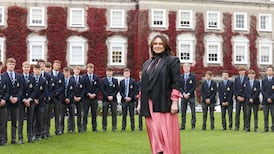By now you'll have heard the terrible rumours that, contrary to what historians and Enya have always led us to believe, we Irish may not be descended from the Celts. I don't know how I'll live with myself if the paternity tests confirm it. But apart perhaps from entering therapy, we should not be thinking of our egos at this difficult time, writes Frank McNally.
Our thoughts should be with the many people whose very livelihoods may now be at risk.
No, I don't mean the Professor of Celtic Archaeology at UCD, whose dilemma - that Ireland has a worrying shortage of Celtic archaeology - was described recently in this newspaper. I mean the thousands of musicians, artists, writers, and new-age mystics whose line of work depends on the notion that we are the survivors of a moody, creative, warrior race, possessed of an ancient wisdom that has disappeared from most of Europe. Even the home-made jewellery sector could be badly hit if the word gets out that it was all a misunderstanding.
The idea of Celtic Ireland is the fossil fuel of Irish popular culture. It certainly has some of the preservative qualities of peat. Artists who have buried themselves in it have sometimes survived intact for decades, their overseas sales protected by the miraculous effects of the surroundings. Trapped in this nether world, they can never fully decompose. And while critics sometimes complain that they can't fully compose either, well, at least they make a living.
Now, too late we may be discovering our over-reliance on a resource that was not merely finite, but fictional. And what is the Department of Arts, Sport, and Tourism - all three of whose sub-sections could be drastically affected by a sudden shortage of Celtic DNA - doing about it? Where is the task force to identify alternative industries and set up retraining programmes? At the very least, there should have been a firm of consultants hired by now.
Sport and tourism will probably survive our reinvention. After all, there is a worrying lack of archaeological evidence that leprechauns ever existed, yet sales of leprechaun products to visitors remain what market analysts call "robust". As for sport, the notion of "fiery Celts" is still central to the perception of our international rugby team in particular, but only abroad. In reality, the team has been kicking the corners and playing percentages for years now, an approach that has been increasingly successful against more passionate but naive teams like the English.
It's in the areas of art, arts and crafts, and - to a lesser extent - toiletries, that a loss of Celtic identity would be felt most acutely. The fact that archaeologists have found no Celtic pottery in Ireland dating from the relevant period only heightens the embarrassment of visiting ceramic workshops all over the country and finding that we have no shortage of it now.
But then, such is the power of our myth-making that the very weather on this island has had Celtic qualities attributed to it. For example, take this randomly selected list of climatological terms: storm, mist, breeze, twilight, ray. Now prefix each word with the adjective "Celtic". You will find that everything on the amended list is one of the following: (a) a Van Morrison song; (b) a compilation folk album; (c) an Irish literary movement; or (d) a type of soap. I rest my case.
The myth of the "Celtic soul" is particularly popular here, but it will be very hard to sustain if it turns out we don't even have Celtic bodies. A small but painful illustration of the dilemma occurs on the popular website anagramgenius.com, which devotes a page to the aforementioned Enya. Apparently by rearranging the letters of "the Celtic singer Enya", you get the phrase "chic, elegant serenity". Impressively apt, you'll agree. Whereas type in "the Irish singer Enya" and the anagram engine throws up nothing better than "high serenity in ears". Only by resorting to dubious spelling and grammar - "hear this syren genii" - do we get a hint of mystique. That's what a change of adjective can mean.
Unsettling as it is, however, we may have to get used to the idea of a non-Celtic Ireland. The new scholarship tells us that the "coming of the Celts" was a myth, popularised by historians who saw invasion and colonisation as the only ways to spread culture. As readers of a certain age will know, this reached a peak with Horslips' landmark album The Book of Invasions (1976). But "invasionism" has now given way to "diffusionism" as the explanation for Celtic influence on Ireland, and you can't dance to that.
Ironically, the one outstanding Celtic artefact we seem to have is Irish, an undisputedly Celtic language that may have spread here without the help, in any great numbers, of actual Celts. This gives rise to some intriguing possibilities. For one thing, in a post-Celtic Ireland, we could discover at last what our ancestors realised from the start: that Irish is a foreign language.
Then, who knows? Maybe speaking it will become popular again.








